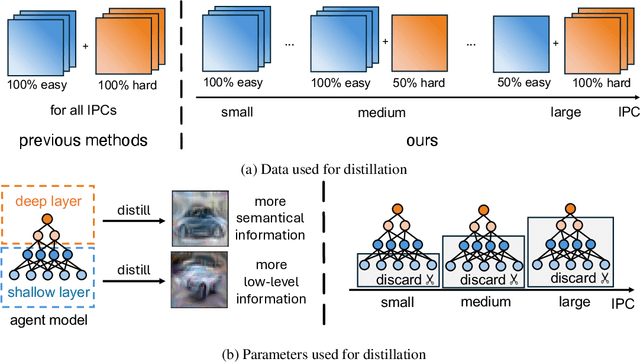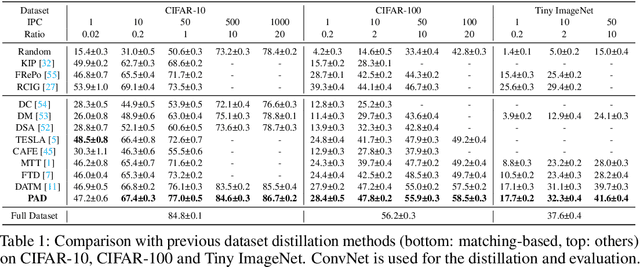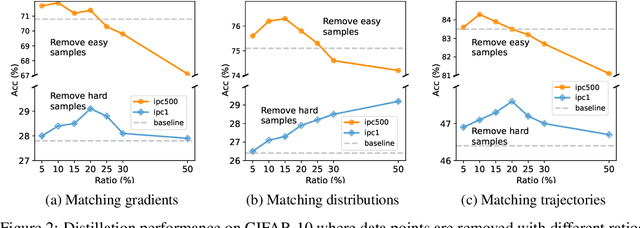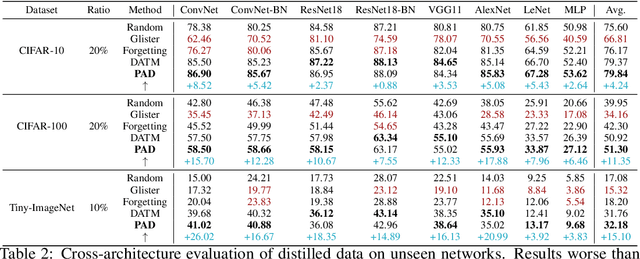Samir Khaki
DD-Ranking: Rethinking the Evaluation of Dataset Distillation
May 19, 2025Abstract:In recent years, dataset distillation has provided a reliable solution for data compression, where models trained on the resulting smaller synthetic datasets achieve performance comparable to those trained on the original datasets. To further improve the performance of synthetic datasets, various training pipelines and optimization objectives have been proposed, greatly advancing the field of dataset distillation. Recent decoupled dataset distillation methods introduce soft labels and stronger data augmentation during the post-evaluation phase and scale dataset distillation up to larger datasets (e.g., ImageNet-1K). However, this raises a question: Is accuracy still a reliable metric to fairly evaluate dataset distillation methods? Our empirical findings suggest that the performance improvements of these methods often stem from additional techniques rather than the inherent quality of the images themselves, with even randomly sampled images achieving superior results. Such misaligned evaluation settings severely hinder the development of DD. Therefore, we propose DD-Ranking, a unified evaluation framework, along with new general evaluation metrics to uncover the true performance improvements achieved by different methods. By refocusing on the actual information enhancement of distilled datasets, DD-Ranking provides a more comprehensive and fair evaluation standard for future research advancements.
Dynamic Vision Mamba
Apr 07, 2025Abstract:Mamba-based vision models have gained extensive attention as a result of being computationally more efficient than attention-based models. However, spatial redundancy still exists in these models, represented by token and block redundancy. For token redundancy, we analytically find that early token pruning methods will result in inconsistency between training and inference or introduce extra computation for inference. Therefore, we customize token pruning to fit the Mamba structure by rearranging the pruned sequence before feeding it into the next Mamba block. For block redundancy, we allow each image to select SSM blocks dynamically based on an empirical observation that the inference speed of Mamba-based vision models is largely affected by the number of SSM blocks. Our proposed method, Dynamic Vision Mamba (DyVM), effectively reduces FLOPs with minor performance drops. We achieve a reduction of 35.2\% FLOPs with only a loss of accuracy of 1.7\% on Vim-S. It also generalizes well across different Mamba vision model architectures and different vision tasks. Our code will be made public.
Data-to-Model Distillation: Data-Efficient Learning Framework
Nov 19, 2024Abstract:Dataset distillation aims to distill the knowledge of a large-scale real dataset into small yet informative synthetic data such that a model trained on it performs as well as a model trained on the full dataset. Despite recent progress, existing dataset distillation methods often struggle with computational efficiency, scalability to complex high-resolution datasets, and generalizability to deep architectures. These approaches typically require retraining when the distillation ratio changes, as knowledge is embedded in raw pixels. In this paper, we propose a novel framework called Data-to-Model Distillation (D2M) to distill the real dataset's knowledge into the learnable parameters of a pre-trained generative model by aligning rich representations extracted from real and generated images. The learned generative model can then produce informative training images for different distillation ratios and deep architectures. Extensive experiments on 15 datasets of varying resolutions show D2M's superior performance, re-distillation efficiency, and cross-architecture generalizability. Our method effectively scales up to high-resolution 128x128 ImageNet-1K. Furthermore, we verify D2M's practical benefits for downstream applications in neural architecture search.
Emphasizing Discriminative Features for Dataset Distillation in Complex Scenarios
Oct 22, 2024Abstract:Dataset distillation has demonstrated strong performance on simple datasets like CIFAR, MNIST, and TinyImageNet but struggles to achieve similar results in more complex scenarios. In this paper, we propose EDF (emphasizes the discriminative features), a dataset distillation method that enhances key discriminative regions in synthetic images using Grad-CAM activation maps. Our approach is inspired by a key observation: in simple datasets, high-activation areas typically occupy most of the image, whereas in complex scenarios, the size of these areas is much smaller. Unlike previous methods that treat all pixels equally when synthesizing images, EDF uses Grad-CAM activation maps to enhance high-activation areas. From a supervision perspective, we downplay supervision signals that have lower losses, as they contain common patterns. Additionally, to help the DD community better explore complex scenarios, we build the Complex Dataset Distillation (Comp-DD) benchmark by meticulously selecting sixteen subsets, eight easy and eight hard, from ImageNet-1K. In particular, EDF consistently outperforms SOTA results in complex scenarios, such as ImageNet-1K subsets. Hopefully, more researchers will be inspired and encouraged to improve the practicality and efficacy of DD. Our code and benchmark will be made public at https://github.com/NUS-HPC-AI-Lab/EDF.
Prioritize Alignment in Dataset Distillation
Aug 06, 2024



Abstract:Dataset Distillation aims to compress a large dataset into a significantly more compact, synthetic one without compromising the performance of the trained models. To achieve this, existing methods use the agent model to extract information from the target dataset and embed it into the distilled dataset. Consequently, the quality of extracted and embedded information determines the quality of the distilled dataset. In this work, we find that existing methods introduce misaligned information in both information extraction and embedding stages. To alleviate this, we propose Prioritize Alignment in Dataset Distillation (PAD), which aligns information from the following two perspectives. 1) We prune the target dataset according to the compressing ratio to filter the information that can be extracted by the agent model. 2) We use only deep layers of the agent model to perform the distillation to avoid excessively introducing low-level information. This simple strategy effectively filters out misaligned information and brings non-trivial improvement for mainstream matching-based distillation algorithms. Furthermore, built on trajectory matching, \textbf{PAD} achieves remarkable improvements on various benchmarks, achieving state-of-the-art performance.
Sparse Refinement for Efficient High-Resolution Semantic Segmentation
Jul 26, 2024Abstract:Semantic segmentation empowers numerous real-world applications, such as autonomous driving and augmented/mixed reality. These applications often operate on high-resolution images (e.g., 8 megapixels) to capture the fine details. However, this comes at the cost of considerable computational complexity, hindering the deployment in latency-sensitive scenarios. In this paper, we introduce SparseRefine, a novel approach that enhances dense low-resolution predictions with sparse high-resolution refinements. Based on coarse low-resolution outputs, SparseRefine first uses an entropy selector to identify a sparse set of pixels with high entropy. It then employs a sparse feature extractor to efficiently generate the refinements for those pixels of interest. Finally, it leverages a gated ensembler to apply these sparse refinements to the initial coarse predictions. SparseRefine can be seamlessly integrated into any existing semantic segmentation model, regardless of CNN- or ViT-based. SparseRefine achieves significant speedup: 1.5 to 3.7 times when applied to HRNet-W48, SegFormer-B5, Mask2Former-T/L and SegNeXt-L on Cityscapes, with negligible to no loss of accuracy. Our "dense+sparse" paradigm paves the way for efficient high-resolution visual computing.
ATOM: Attention Mixer for Efficient Dataset Distillation
May 02, 2024Abstract:Recent works in dataset distillation seek to minimize training expenses by generating a condensed synthetic dataset that encapsulates the information present in a larger real dataset. These approaches ultimately aim to attain test accuracy levels akin to those achieved by models trained on the entirety of the original dataset. Previous studies in feature and distribution matching have achieved significant results without incurring the costs of bi-level optimization in the distillation process. Despite their convincing efficiency, many of these methods suffer from marginal downstream performance improvements, limited distillation of contextual information, and subpar cross-architecture generalization. To address these challenges in dataset distillation, we propose the ATtentiOn Mixer (ATOM) module to efficiently distill large datasets using a mixture of channel and spatial-wise attention in the feature matching process. Spatial-wise attention helps guide the learning process based on consistent localization of classes in their respective images, allowing for distillation from a broader receptive field. Meanwhile, channel-wise attention captures the contextual information associated with the class itself, thus making the synthetic image more informative for training. By integrating both types of attention, our ATOM module demonstrates superior performance across various computer vision datasets, including CIFAR10/100 and TinyImagenet. Notably, our method significantly improves performance in scenarios with a low number of images per class, thereby enhancing its potential. Furthermore, we maintain the improvement in cross-architectures and applications such as neural architecture search.
The Need for Speed: Pruning Transformers with One Recipe
Mar 26, 2024



Abstract:We introduce the $\textbf{O}$ne-shot $\textbf{P}$runing $\textbf{T}$echnique for $\textbf{I}$nterchangeable $\textbf{N}$etworks ($\textbf{OPTIN}$) framework as a tool to increase the efficiency of pre-trained transformer architectures $\textit{without requiring re-training}$. Recent works have explored improving transformer efficiency, however often incur computationally expensive re-training procedures or depend on architecture-specific characteristics, thus impeding practical wide-scale adoption. To address these shortcomings, the OPTIN framework leverages intermediate feature distillation, capturing the long-range dependencies of model parameters (coined $\textit{trajectory}$), to produce state-of-the-art results on natural language, image classification, transfer learning, and semantic segmentation tasks $\textit{without re-training}$. Given a FLOP constraint, the OPTIN framework will compress the network while maintaining competitive accuracy performance and improved throughput. Particularly, we show a $\leq 2$% accuracy degradation from NLP baselines and a $0.5$% improvement from state-of-the-art methods on image classification at competitive FLOPs reductions. We further demonstrate the generalization of tasks and architecture with comparative performance using Mask2Former for semantic segmentation and cnn-style networks. OPTIN presents one of the first one-shot efficient frameworks for compressing transformer architectures that generalizes well across different class domains, in particular: natural language and image-related tasks, without $\textit{re-training}$.
ProbMCL: Simple Probabilistic Contrastive Learning for Multi-label Visual Classification
Jan 02, 2024Abstract:Multi-label image classification presents a challenging task in many domains, including computer vision and medical imaging. Recent advancements have introduced graph-based and transformer-based methods to improve performance and capture label dependencies. However, these methods often include complex modules that entail heavy computation and lack interpretability. In this paper, we propose Probabilistic Multi-label Contrastive Learning (ProbMCL), a novel framework to address these challenges in multi-label image classification tasks. Our simple yet effective approach employs supervised contrastive learning, in which samples that share enough labels with an anchor image based on a decision threshold are introduced as a positive set. This structure captures label dependencies by pulling positive pair embeddings together and pushing away negative samples that fall below the threshold. We enhance representation learning by incorporating a mixture density network into contrastive learning and generating Gaussian mixture distributions to explore the epistemic uncertainty of the feature encoder. We validate the effectiveness of our framework through experimentation with datasets from the computer vision and medical imaging domains. Our method outperforms the existing state-of-the-art methods while achieving a low computational footprint on both datasets. Visualization analyses also demonstrate that ProbMCL-learned classifiers maintain a meaningful semantic topology.
DataDAM: Efficient Dataset Distillation with Attention Matching
Sep 29, 2023Abstract:Researchers have long tried to minimize training costs in deep learning while maintaining strong generalization across diverse datasets. Emerging research on dataset distillation aims to reduce training costs by creating a small synthetic set that contains the information of a larger real dataset and ultimately achieves test accuracy equivalent to a model trained on the whole dataset. Unfortunately, the synthetic data generated by previous methods are not guaranteed to distribute and discriminate as well as the original training data, and they incur significant computational costs. Despite promising results, there still exists a significant performance gap between models trained on condensed synthetic sets and those trained on the whole dataset. In this paper, we address these challenges using efficient Dataset Distillation with Attention Matching (DataDAM), achieving state-of-the-art performance while reducing training costs. Specifically, we learn synthetic images by matching the spatial attention maps of real and synthetic data generated by different layers within a family of randomly initialized neural networks. Our method outperforms the prior methods on several datasets, including CIFAR10/100, TinyImageNet, ImageNet-1K, and subsets of ImageNet-1K across most of the settings, and achieves improvements of up to 6.5% and 4.1% on CIFAR100 and ImageNet-1K, respectively. We also show that our high-quality distilled images have practical benefits for downstream applications, such as continual learning and neural architecture search.
* Accepted in International Conference in Computer Vision (ICCV) 2023
 Add to Chrome
Add to Chrome Add to Firefox
Add to Firefox Add to Edge
Add to Edge